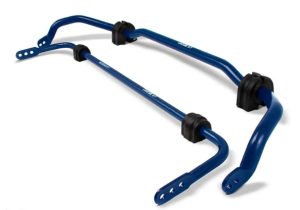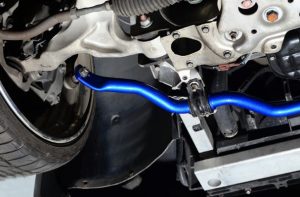Stabilizer bars — also known as sway bars or anti-roll bars — play a crucial yet often misunderstood role in vehicle handling. Despite their importance, many drivers carry misconceptions about how sway bars work, what they affect, and how to set them up properly. Let’s tackle these myths head-on and clarify how stabilizers truly impact ride quality, handling, and safety.

Myth 1: A Sway Bar Stiffens the Ride
Reality:
Sway bars don’t directly affect ride comfort. Their job is to reduce body roll during cornering by linking the left and right sides of the suspension together. When one side compresses more than the other, the bar twists, resisting further tilt.
-
Straight-line travel: Sway bar is inactive —zero impact on comfort.
-
Cornering: Reduces lean, keeps the car more level.
Key Takeaway:
Ride stiffness remains dictated by your springs and shocks — not by the sway bar.
Myth 2: Bigger Sway Bars = Better Handling
Reality:
A thicker bar simply increases roll resistance — but it’s not a silver bullet.
| Bar Size | Effect on Handling |
|---|---|
| Too stiff | May understeer (front bar) or oversteer (rear bar) |
| Balanced setup | Harmonious cornering, improved traction |
| Too soft | Excessive body roll, vague handling feel |
Balanced Approach:
Focus on pairing bar size with spring and damper setup — not just upgrading to the heaviest bar possible.
Myth 3: Removing the Sway Bar Improves Off-Road Ride
Reality:
While ditching the sway bar may allow more wheel articulation, it compromises handling severely.
Trade-Offs:
-
Offers better articulation on rough terrain
-
Increases body roll and unpredictable behavior on-road
-
Body roll raises risk of rollover during sudden maneuvers
Tip: Use detachable or disconnectable sway bars for vehicles driven on-and-off-road.
Myth 4: Upgrading a Sway Bar Fixes All Body Roll Issues
Reality:
If excessive body roll stems from soft springs or worn shocks, beefing up the sway bar won’t solve the root cause.
-
Fix springs/shocks first: Renew or upgrade before adjusting anti-roll bars.
A rough maintenance list:
-
Springs: check sag and age
-
Shock absorbers: look for leaks
-
Suspension bushings: inspect wear and tear
Only then should you consider sway bar upgrades for fine-tuning handling.
Myth 5: Adjustable Sway Bars Are Overkill for Daily Use
Reality:
Adjustable bars bring versatility — not just for racers.
When adjustable bars shine:
-
Towing or hauling: reinforce rear sway bar
-
Seasonal shifts (e.g. snow ➔ summer)
-
Multiple drivers with different driving styles
These allow easy tuning without swapping hardware.
Myth 6: Front Sway Bar Swap Alone Is Enough
Reality:
Upgrading only the front bar could unbalance handling, leading to understeer or oversteer.
Preferred Strategy:
Balance both ends — if you enhance the front bar, adjust the rear bar accordingly to maintain neutral handling.
Setup Table:
| Upgrade Scenario | Add Front Bar | Add Rear Bar |
|---|---|---|
| Track/spirited use | Yes | Yes |
| Daily commuting | Optional | Optional |
| Towing | Yes (rear priority) | Yes |
| Off-road | May disconnect | Usually connected |
Myth 7: Heavy Vehicles Don’t Need Sway Bars
Reality:
All vehicles, heavy or light, benefit from proper sway bar tuning:
-
Heavy SUVs/vans: Prevent body roll and enhance rollover resistance
-
Performance cars: Sharpen steering and reduce correction time
-
Loaded wagons/trailers: Keep load stable and avoid sway
Sway bars contribute to both handling and safety, regardless of vehicle weight.
Quick Reference: Sway Bar Know‑How
| Myth | Truth |
|---|---|
| “Bigger bar = better handling” | Balance bar with spring/damper setup |
| “Sway bar removal softens ride” | No impact on straight-line comfort |
| “Front bar upgrade is enough” | Both front and rear must be tuned |
| “Adjustable bars are unnecessary” | They boost versatility and adaptability |
When and How to Upgrade

-
Diagnose handling imbalance via skidpad/testing
-
Renew worn shocks/springs before adding sway bars
-
Start with moderate upgrades and test extensively
-
Balance front/rear anti-roll stiffness
-
Choose adjustable bars if load/towing varies often
Suspension Tuning Hierarchy
-
Springs
-
Shock absorbers
-
Bushings/mounts
-
Sway bars
Want to Improve Your Handling?
If you’re ready to fine‑tune your setup or need a replacement stabilizer, explore quality options here: Buy Stabilizer & Components online
Final Thoughts
Sway bars are among the most misunderstood yet essential suspension components. They don’t stiffen ride quality, nor are bigger always better. Their real value lies in controlling body roll, creating balanced handling, and improving safety. Avoid quick fixes and embrace a well-rounded suspension tuning approach — only then will sway bars truly shine.
Remember: correct sway bar tuning complements — not replaces — good maintenance and overall suspension harmony. Drive safe and enjoy the road!